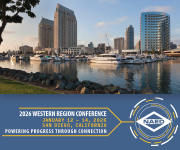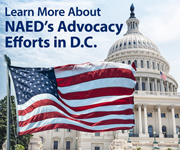Silver Spring, MD – The many benefits associated with light-emitting diode (LED) illumination explain why it has “accelerated into the market place over the last decade at an unprecedented rate for a new light source,” said OSRAM SYLVANIA Director of Government & Industry Relations Mark Lien, L.C., CLEP, CLMC, HBDP, LEED BD&C, the lead-off speaker for a panel of experts that the National Lighting Bureau assembled to discuss the challenges of specifying LEDs.
The key challenge associated with LED lighting, panelists said, is rapid obsolescence. With other forms of lighting, system designers have grown used to having the specified products delivered to the construction site when needed, typically 12 to 18 months after the designers specified them. The pace of LED research and development is far faster than that associated with “legacy products,” however, in part because so many more manufacturers are involved. As a result, manufacturers must replace many relatively new products with even newer versions, just to keep pace with competitors. The upshot all too often is manufacturers and distributors being unable to deliver the specified products when needed, because the products are no longer available. When that happens, the designers may sometimes have to revise the proposed lighting system to minimize construction delays, creating a somewhat large, unanticipated expense for an owner or construction manager.
A related problem associated with LEDs is the premature failure of systems and components, especially those manufactured by companies that are relatively new to lighting. While a failure can be frustrating, it can expand into something far more troublesome when the failed components cannot be replaced, because they no longer are available or because the company that manufactured them is no longer in business. Panelists also expressed some concern about wireless lighting-control technology and its potential for interference with other wireless operations that may be ongoing in a space.
The panelists stressed the fact that LED lighting is here to stay, because of benefits such as efficiency and long life, the ability to fine tune both color and beam spread, dimming, instant-on outdoor operation, and high levels of uniformity. The panel moderator – Edison Report Publisher Randy Reid – suggested that the problem may not be so much LED lighting as it is a specification system that may need a complete overhaul to deal with today’s new lighting realities.
The panel discussion is available for free viewing at the National Lighting Bureau website. The National Lighting Bureau directors who participated in the discussion included:
Howard P. Lewis (Viscor Group of Companies), Illuminating Engineering Society;
Mark Lien, L.C., CLEP, CLMC, HBDP, LEED BD&C, Director, Government & Industry relations, OSRAM SYLVANIA;
Janet Lennox Moyer, Founder, International Landscape Lighting Institute;
Brooke Silber, Principal, Jan & Brooke, Luminae, LLC; and
James M. Yorgey, P.E., L.C., Technical Applications Manager, Lutron Electronics Company, Inc.
The National Lighting Bureau is an independent, IRS-recognized not-for-profit, educational foundation that has served as a trusted lighting-information source since 1976. The Bureau’s services are made possible by the generous funding of its sponsors; professional societies, trade associations, manufacturers, and agencies of the U.S. government, including:
GE Lighting;
Illuminating Engineering Society of North America (IES);
Imperial Lighting Maintenance Company;
interNational Association of Lighting Management Companies (NALMCO);
International Landscape Lighting Institute;
Jan & Brooke Luminae, LLC
Lighting Controls Association;
LumenOptix;
Lutron Electronics Company, Inc.;
Magnaray;
National Electrical Contractors Association (NECA);
National Electrical Manufacturers Association (NEMA);
OSRAM SYLVANIA;
U.S. General Services Administration; and
Viscor Group of Companies.
Obtain more information about the Bureau by visiting http://www.nlb.org





